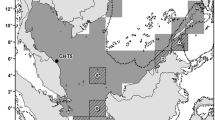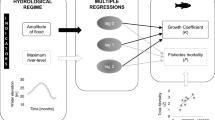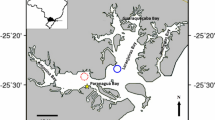Abstract
The population dynamics of a Donax dentifer (Hanley, 1843) population from Málaga bay, Colombia, was studied during two periods (August 1997–July 1998 and November 1999–February 2002) in order to investigate the effects of El Niño (EN) 1997/1998 and La Niña (LN) 1998/2000. The EN–LN cycle was strongly associated to an interannual precipitation and salinity variability in Málaga bay. Additionally, these factors were highly correlated with the reproductive cycle. Results indicate that EN had negative effects on the reproductive cycle, leading to weak, abnormal spawning events. In contrast, good spawning events were recorded during LN and post-LN. Based on these findings, an opportunistic reproductive strategy is proposed for this species. Overall growth performance (P) was higher during LN (P=4.41) than during EN and post-LN (P=4.20, P=4.28, respectively). These results indicate that D. dentifer has a higher overall growth performance compared to several tropical species reported in the literature. Total mortality rate of small individuals was higher during LN whereas that of large individuals was higher during EN. These results are best explained by recruitment variability and spatial differences between recruits and adults. Individual production and productivity were higher during LN, although annual biomass was relatively low. This, together with the results regarding growth and reproduction, suggests that food availability was higher during LN, thus positive effects under LN may be concluded. In contrast, EN seems to have negative effects on growth, reproduction and somatic production for this surf clam.







Similar content being viewed by others
References
Ardila C, Cantera JR (1988) Diagnóstico de la pesca artesanal de moluscos en algunas regiones del Pacífico colombiano. Memorias VI Seminario Nacional de Ciencias y Tecnologías del Mar. Santafé de Bogotá, Colombia, pp 141–168
Arntz WE, Fahrbach E (1996) El Niño: Experimento climático de la naturaleza. Fondo de Cultura Económica, México
Bertalanffy von L (1938) A quantitative theory of organic growth (inquiries on growth laws II). Hum Biol 10(2):181–213
Birkett D, Cook P (1987) Effect of the Benguela temperature anomaly, 1982–1983, on the breeding cycle of Donax serra Röding. In: Payne AIJ, Gulland JA, Brink KH (eds) The Benguela and comparable ecosystems. S Afr J mar Sci, vol 5, pp 191–196
Cantera JR, Blanco JF (2001) The estuary ecosystem of Buenaventura Bay, Colombia. In: Seeliger U, Kjerfve B (eds) Coastal marine ecosystems of Latin America. Ecological studies, vol 144. Springer, Berlin Heidelberg New York, pp 264–280
Chavez FP, Strutton PG, Friederich GE, Feely RA, Feldman GC, Foley DG, McPhaden MJ (1999) Biological and chemical response of the equatorial Pacific Ocean to the 1997–98 El Niño. Science 286:2126–2131
Chavez FP, Ryan J, Lluch-Cota SE, Ñiquen M (2003) From anchovies to sardines and back: multidecadal change in the Pacific Ocean. Science 299:217–221
Crisp DJ (1984) Energy flow measurements. In: Holme NA, McIntyre AD (eds) Methods for the study of marine benthos. Blackwell, London, pp 284–372
Espino M (1999) “El Niño 1997–98”: su efecto sobre el ambiente y los recursos pesqueros en el Perú. Rev Peru Biol Vol Extraordinario, pp 97–109
Fabens AJ (1965) Properties and fitting of the von Bertalanffy growth curve. Growth 29:265–285
Fong P, Glynn PW (2002) A regional model to predict coral population dynamics in response to El Niño-Southern Oscillation. Ecol Appl 10:842–854
Glantz MH (1997) Currents of change, El Niño’s impact on climate and society. Cambridge University Press, Cambridge
Glynn PW (2000) A biogeographic analysis and review of the far eastern Pacific coral reef region. Coral Reefs 19:1–23
Glynn PW (2001) A collection of studies on the effects of the 1997–98 El Niño Southern Oscillation event on corals and coral reefs in the eastern tropical Pacific. Bull Mar Sci 69:1–288
Gocke K, Cortéz J, Murillo M (2001) The annual cycle of primary production in a tropical estuary: the inner regions of the Golfo de Nicoya, Costa Rica. Rev Biol Trop 49:289–306
Hernández CA, Gocke K (1990) Productividad primaria en la Ciénaga Grande de Santa Marta, Colombia. An Inst Invest Mar Punta Betín 19–20:101–119
Jiménez CE, Cortéz J (2003) Coral cover change associated to El Niño, Eastern Pacific, Costa Rica, 1992–2001. Mar Ecol 24:179–193
Kelmo F, Attrill MJ, Gomes RC, Jones MB (2004) El Niño induced local extinction of coral reef bryozoan species from Northern Bahia, Brazil. Biol Conserv 118:609–618
Kjerfve B, Seelinger U, Drude De Lacerda L (2001) A summary of natural and human-induced variables in coastal marine ecosystems of Latin America. In: Seeliger U, Kjerfve B (eds) Coastal marine ecosystems of Latin America. Ecological studies, vol 144. Springer, Berlin Heidelberg New York, pp 341–352
Laudien J, Brey T, Arntz WE (2001) Reproduction and recruitment patterns of the surf clam Donax serra (Bivalvia, Donacidae) on two Namibian sandy beaches. S Afr J Mar Sci 23:53–60
Laudien J, Brey T, Arntz WE (2003) Population structure, growth and production of the surf clam Donax serra (Bivalvia, Donacidae) on two Namibian Sandy beaches. Estuar Coast Shelf Sci 58S:105–115
Marinovic BB, Croll DA, Gong N, Benson SR, Chavez FP (2002) Effects of the 1997–1999 El Niño and La Niña events on zooplankton abundance and euphasiid community composition within the Monterrey Bay coastal upwelling system. Prog Oceanogr 54(1–4):265–277
McPhaden MJ (1999) Genesis and evolution of the 1997–98 El Niño. Science 283:950–954
Medeiros C, Kjerfve B, Araujo M, Newmann-Leitao S (2001) The Itamaracá estuarine ecosystem, Brazil. In: Seeliger U, Kjerfve B (eds) Coastal marine ecosystems of Latin America. Ecological studies, vol 144. Springer, Berlin Heidelberg New York, pp 71–81
Munro JL, Pauly D (1983) A simple method for comparing the growth of fishes and invertebrates. Fishbyte 1:5–6
Nakaoka M (1992) Spatial and seasonal variation in growth rate and secondary production of Yolida notabilis in Otsuchi Bay, Japan, with reference to the influence of food supply from the water column. Mar Ecol Prog Ser 88:215–223
Pauly D (1979) Gill size and temperature as governing factors in fish growth: a generalization of von Bertalanffy’s growth formula. Beri Inst MeeresKde Kiel 6:1–156
Pauly D (1983) Length-converted catch curves. A powerful tool for fisheries research in the tropics. Part I. Fishbyte 1(2):9–13
Peterson CH (1982) The importance of predation and intra-and interspecific competition in the population biology of two infaunal suspension-feeding bivalvles, Protothaca staminea and Chione undatella. Ecol Monogr 52:437–475
Prahl von H, Cantera JR, Contreras R (1990) Manglares y hombres del Pacífico Colombiano. Colciencias & Fondo FEN Colombia, Bogotá
Press WH, Flannery BP, Teukolsky SA, Vetterling WT (1996) Numerical recipes. The art of scientific computing. Cambridge University Press, Cambridge
Restrepo JD, Kjerfve B (2000) Water and sediment discharges from the western slopes of the Colombian Andes with focus on Rio San Juan. J Geol 108:17–133
Restrepo JD, Kjerfve B, Correa ID, Gonzalez J (2002) Morphodynamics of a high discharge tropical delta, San Juan River, Pacific coast of Colombia. Mar Geol 192:355–381
Riascos JM (1999) Dinámica poblacional de Donax dentifer (Hanley, 1843) (Mollusca: bivalvia, donacidae) en Bahía Málaga, Pacífico colombiano durante el fenómeno “El Niño”. Undergraduate Thesis. Universidad del Valle. Cali-Colombia
Riascos JM (2002) Cambios en el macrobentos de playa arenosa durante “El Niño” 1997–98 en la Bahía de Málaga, Pacífico colombiano. Cienc Mar 28:13–25
Riascos JM, Rallón NI (2001) Patrones de distribución espacial del macrobentos de playa arenosa en el Pacífico colombiano. Actual Biol 23:15–20
Richey JE, Nobre C, Deser C (1989) Amazon River discharge and climate variability: 1903 to 1985. Science 246:101–103
Rubio E (1984) Estudio taxonómico preliminar de la Ictiofauna de la bahía de Málaga. An Inst Inv Mar Punta Betín 14:157–173
Ryan JP, Polito PS, Strutton PG, Chavez FP (2002) Unusual large-scale phytoplankton blooms in the equatorial Pacific. Prog Oceanogr 55(3–4):263–245
Sastre MP (1984) Relationship between environmental factors and Donax denticulatus populations in Puerto Rico. Estuar Coast Shelf Sci 19:217–230
Shoeman DS, Richardson AJ (2002) Investigating biotic and abiotic factors affecting the recruitment of an intertidal clam on an exposed sandy beach using a generalized additive model. J Exp Mar Biol Ecol 276:67–81
Urban H-J (2000) Culture pontential of the pearl oyster (Pinctadda imbricata) from the Caribbean. I. Gametogenic activity, growth, mortality and production of a natural population. Aquaculture 189:361–373
Urban H-J (2001) Reproductive strategies in tropical bivalves (Pteria colymbus, Pinctada imbricata and Pinna carnea): temporal coupling of gonad production and spat abundance related to environmental variability. J Shellfish Res 20(3):1127–1134
Urban H-J, Riascos JM (2002) Estimating gonado-somatic indices in bivalves with fused gonads. J Shellfish Res 21(1):249–253
Urban H-J, Tarazona J (1996) Effects of El Niño/Southern Oscillation on the populations dynamics of a Gari solida population (Bivalvia: Psammobiidae) from Bahía Independencia, Perú. Mar Biol 125:725–734
Vörösmarty CJ, Willmott CJ, Choudhury BJ, Schloss AL, Stearns TK, Robeson SM, Dormanl TJ (1996) Analyzing the discharge regime of a large tropical river through remote sensing, ground-based climatic data, and modeling. Water Resour Res 32:3137–3150
Wade BA (1967) Studies on the biology of the West Indian beach clam, Donax denticulatus Linné. I. Ecology. Bull Mar Sci 17:149–175
Wade BA (1968) Studies on the biology of the West Indian beach clam, Donax denticulatus Linné. 2. Life-history. Bull Mar Sci 18:876–901
Wang HJ, Zhang RH, Cole J, Chavez F (1999) El Niño and the related phenomenon Southern Oscillation (ENSO): the largest signal in interannual climate variation. Proc Natl Acad Sci USA 96:11071–11072
Acknowledgements
This study was financed by the Biological Impact Network of EN events (RIBEN-OEA) and was finished in the framework of CENSOR (Climate variability and ENSO: implications for natural coastal resources and management) financed by the European Commission. Dr Jürgen Laudien gave valuable comments on an earlier draft of the manuscript. Special thanks to Norma Ibon Rallón who provided permanent intellectual stimulation. Angela Perez, Angela Navarrete and Cristina Murillo supported field and laboratory work. My gratitude is expressed to Luis Alonso Zapata, Germán Parra and Thomas J. Ashton. All the experiments conducted in this study comply with the current laws of Colombia. This is CENSOR publication 002.
Author information
Authors and Affiliations
Corresponding author
Additional information
Communicated by P.W. Sammarco, Chauvin
Rights and permissions
About this article
Cite this article
Riascos V., J.M. Effects of El Niño-Southern oscillation on the population dynamics of the tropical bivalve Donax dentifer from Málaga bay, Colombian Pacific. Marine Biology 148, 1283–1293 (2006). https://doi.org/10.1007/s00227-005-0165-4
Received:
Accepted:
Published:
Issue Date:
DOI: https://doi.org/10.1007/s00227-005-0165-4




